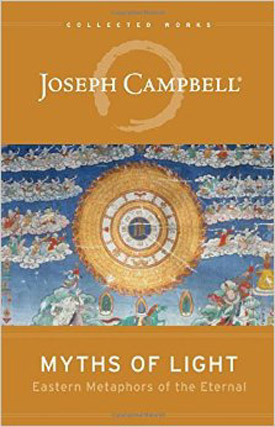 Joseph Campbell, to those who have an interest in mythology as something other than stories, is a name that should be instantly recognizable. Through his writings he has pulled together the strands of mythology, folklore, psychology, and how they all work, into a synthesis that offers a solid perspective on how these metaphors determine how we see the world.
Joseph Campbell, to those who have an interest in mythology as something other than stories, is a name that should be instantly recognizable. Through his writings he has pulled together the strands of mythology, folklore, psychology, and how they all work, into a synthesis that offers a solid perspective on how these metaphors determine how we see the world.
In Myths of Light, a group of lectures and unpublished writings edited by David Kudler, he turns his attention to what he calls the “Orient” — those civilizations and mythic traditions east of a line through Persia that, as Campbell notes, separates the East — India, China and Japan — from the West — the Levant and Europe. He not only notes the essential differences in world view between these civilizations, but also their areas of similarity — once again finding the commonality that underlies all of our various religious traditions.
Campbell begins his Introduction by noting one very important point: “Myths do not, properly, belong to the rational mind. Rather, they bubble up from deep in the wells of what Carl Jung called the collective unconscious.” That’s the best short explanation of mythology and its importance that I’ve ever seen.
The first chapter, “The Birth of Brahman,” is, in essence, a historical/philosophical exploration of the Eastern idea of “god” as it has developed since the first appearance of civilization, about 2500 BCE in the Indus Valley and the Middle East, and not quite a thousand years later in China. Campbell concentrates on developments in India, where the culture and religious thought of the invading Indo-Europeans was gradually synthesized with the native Dravidian culture. The foundation of this religious tradition is that the universe is not ruled by a “personal god,” but is instead the apprehendible part of a mathematically consistent system: the gods did not create the universe and are as subject to its rules as are the rest of us. (Reviewer’s note: This is consistent with the assumptions of other cultures, most notably, in my experience, those of pre-Christian Europe and pre-Columbian North America, which is a point that Campbell alludes to, but doesn’t really stress.)
Chapter Two, “The Jiva’s Journey,” casts the argument in what is essentially a metaphor, yoga — the journey of the kundalini, the “serpent of the chakras,” up through the various stages of enlightenment, marked by the seven chakras, the centers of consciousness, until the final revelation — that consciousness itself is an impediment to full enlightenment. This chapter is the most extensive, the heaviest sledding, but in many ways the most informative: Campbell pulls in a number of myths and anecdotes to explicate the philosophical concepts being introduced, most of which really don’t lend themselves to rational exposition.
The key concept from “The Jiva’s Journey” is that the reincarnating principle (and this has been about reincarnation) possesses no individuality, no uniqueness. That’s the point, that’s the goal toward which the soul strives — although the striving itself holds the sould back. The ideal is to achieve transcendence without trying. “Vessels to the Farther Shore” investigates the responses to this idea in Jainism, Hinduism, and Buddhism. The “envoy” the final chapter, “The Tiger in the Depths,” is a coda, encapsulated, as Campbell so often does, in a story, this one from India, about a tiger who thought he was a goat. In these two final sections, Campbell’s signature informal style comes into its own — they are relaxed, fluent, and somewhat deceptive: he’s still introducing concepts, connecting dots, illuminating insights, but he sneaks past your defenses. I found myself sometimes almost gasping in recognition as connections became plain.
As is usual with the writings of Joseph Campbell, here’s much more to the book than I can relate in the limited space of a review. Myths of Light draws together the strands of religious thought from around the world — and he does spend time comparing and contrasting East and West in that regard — into a coherent narrative that can’t help but be illuminating.
(New World Library, 2003)
